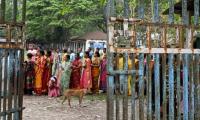The availability of affordable housing remains a nightmare for middle and lower income groups in Pakistan, despite the government’s ambitious agenda to build five million affordable housing units in five years.
Three important aspects of housing are: i) assessment of future need; ii) affordability; and iii) sustainability, should be taken into account when developing a national housing policy in Pakistan.
Existing housing does not meet national needs. Estimates, based on the Pakistan Social and Living Standards Measurement Survey (PSLM) and Census 2017, show that existing housing stocks are around 23.8 million housing units, while housing needs are around 34.1 million housing units. This implies that Pakistan is currently facing a total housing backlog of 10.3 million housing units.
The shortage of urban housing is estimated at around 3.4 million housing units (housing needs are 12.5 million units, while current stocks are only 9.2 million units), while the shortage of rural housing is over 7 million housing units (housing needs are 21.5 million units, while current stocks are only 14.6 million units).
Province wise estimates show that the housing shortage in Punjab is around 5.5 million housing units, followed by Sindh (3.1 million housing units), Khyber Pakhtunkhwa (1.3 million housing units) and Balochistan (0.5 million housing units). In percentage terms, Sindh has the highest shortage (57 percent of current housing stock), followed by Balochistan (42 percent), Punjab (40 percent) and Khyber Pakhtunkhwa (37 percent).
Income wise analysis shows that housing needs are higher among low-income groups (two lowest quintiles) and the lowest among the richest quintile (based on five quintiles ranging from the poorest to the richest). This reflects the great shortage of housing units among low and middle income groups. More than 5.2 million housing units are needed to accommodate low income groups, while only 0.5 million housing units are needed to accommodate the richest group.
Several factors, such as population growth, urbanization and economic development, determine housing demand. The population in Pakistan is expected to reach 250 million by 2025 with an average growth rate of 2.4 percent. More than 50 percent population is expected to live in urban areas between 2030 and 2040.
Based on the expected population growth, the decrease in household size, the increase in urbanization, the trend toward migration and the replacement of existing housing units, the housing demand is expected to grow from 1.07 million housing units per year in 2020 to 1.24 million housing units per year in 2025. The cumulative demand for new housing units will increase from 1.07 million in 2020 to 6.9 million housing units in 2025.
Taking into account the current backlog of 10.3 million housing units, future housing demand will increase from 11.4 million in 2020 housing units to 17.2 million housing units in 2025. Demand is mainly driven by the economically weaker segments of the population, which raises a huge concern on the affordability of housing.
To overcome the housing deficit, an investment of approximately 83 percent of GDP is required in 2020, considering the average price of a house with three living rooms of approximately three million (according to several websites that deal with the sale and purchase of houses). This raises a question: where does this investment come from? Do we have enough supplies, including construction material and land spaces to build these houses? This requires an innovative approach to design high rise building for optimal use of land and construction material.
When it comes to public housing schemes, affordability is the most important aspect. The household per capita income is around Rs29,150 (based on the Household Integrated Economic Survey (HIES) 2015-16). Standard literature shows that housing is affordable if the price of a housing unit is less than seven times the annual income of the household, as Mumtaz and Shaikh mentioned in a blog titled, ‘A framework for affordable housing in Pakistan’. The seven-time annual income is around 2.4 million, which is less than the required amount of three million. These conditions are even worse among the poor segments of society. This, once again, requires innovative solutions to provide low-cost housing to poor segments of society
The sustainability of a housing unit is as important as the affordability. Given the rapid population growth and climate change, housing schemes should focus on sustainability along with affordability. Estimates based on the PSLM shows that around 21 percent housing units are not sustainable even in terms of construction. While around 20 percent households do not even have access to sanitation facilities in the house.
The factors lead us to consider the sustainability dimension of the house to promote health and well-being. A well-framed housing policy that aims at sustainability from all angles including environment, social and economics is required. The environmental sustainability of housing refers to construction, which is energy efficient, comfortable for living, efficient waste disposal system and alternative source of energy. Sustainable housing maximizes the general wellbeing of houses and minimizes environmental cost.
An award winning Japanese project on sustainable housing, ‘The Fukasawa Symbiotic Housing Complex’, can be reviewed to frame policy guidelines for sustainable housing. This success of the project is testimony to the fact that good housing schemes that are economically profitable and financially feasible can be undertaken while addressing environmental concerns at the same time.
Pakistan not only lacks in sustainability consideration in its housing policy, it even lacks a housing policy till 2001. The policy remains unchanged even 19 years after its formulation, despite the changing development paradigm from millennium development to sustainable development.
There is a need to revise the existing housing policy to include the sustainability element. The government should revise regulations to ensure that new housing units developed by either the private sector or the public sector should ensure sustainability elements from social, economic and environmental perspectives.
The writer is associate professor at the Pakistan Institute ofDevelopment Economics (PIDE).
Email: dr.iqbaln@gmail.com
A woman walks past a building of the International Monetary Fund. — AFP/FileThe annual and spring meetings of the...
Late Benazir Bhutto's daughter Asifa Bhutto Zardari addresses the Christian community in Bihar Colony on January 23,...
Representational image. — PexelsWater is an important scarce natural resource that is required for several everyday...
Pakistani employees of online marketplace company Kaymu at work in Karachi. — AFP/FileThe true spirit of development...
India uses Afghanistan as a backstage area to carry out terrorist attacks against Pakistan
Another report by the Pakistan Institute of Peace Studies states that 78 per cent of attacks have been carried out by...







